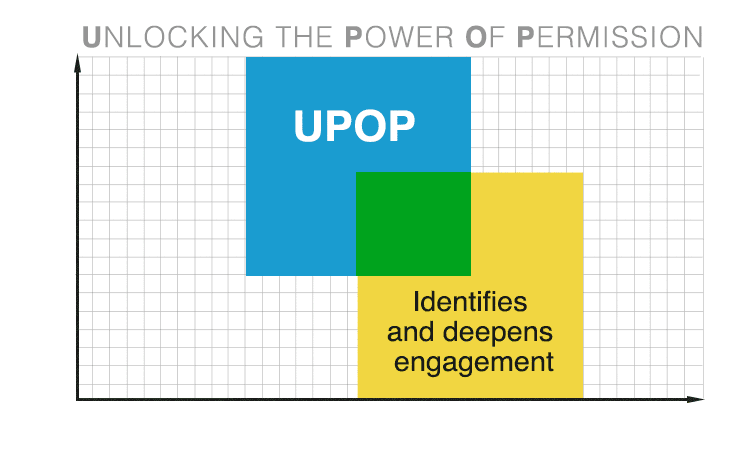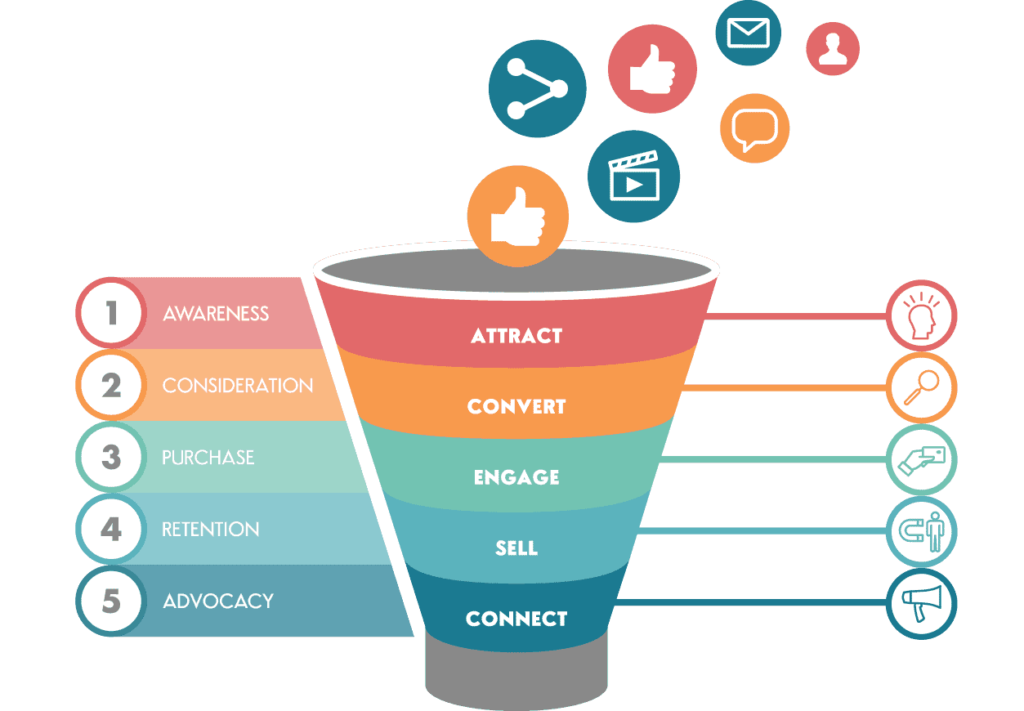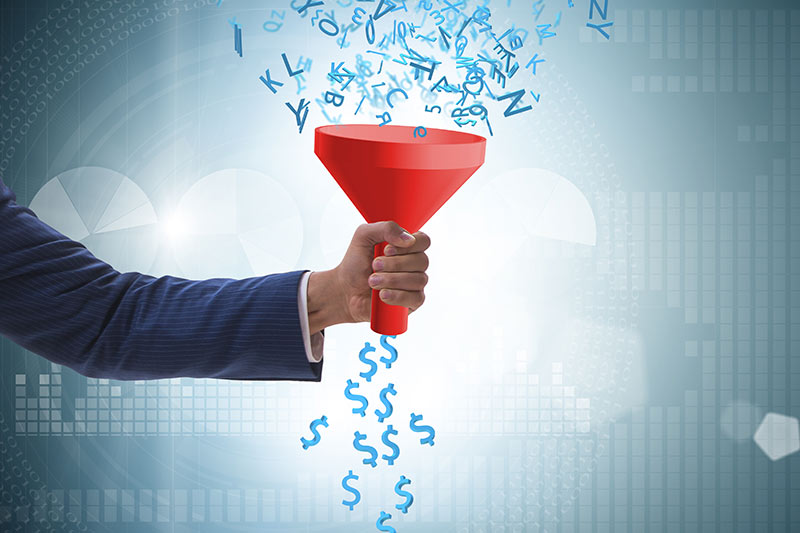Better Marketing
Building a marketing funnel will help you make more sales
You may have heard of a marketing funnel before, but what you might not know is they’ve been around for a long, long time.
Originally identified in 1898 by the wonderfully-named American ad man, Elias St. Elmo Lewis, funnels represent the steps a customer might take from being blissfully unaware of your product or service, all the way through to making a purchase.
The idea is that if you know the possible ‘journey’ a potential customer takes, you can step in at key points along the way, to try and influence them to progress along the journey (ie down the funnel) towards the point where they buy your product, and not your competitor’s.
If you ignore the ‘journey’ and go straight for the sale, you can be quickly rejected by your prospect because you haven’t established familiarity or trust. Here’s how we see that:
Although the concept has stayed the same over the years, the number of ways you can influence a prospect has increased to a dazzling amount, and therein lies the confusion for many business owners today.
So let’s try and strip away the clutter, get back to basics, and explain how to start funnelling for fun and profit!
How do I develop a marketing funnel for my business?
Well, having been around the traps for longer than we care to remember, we’ve actually developed our own approach to the concept of funnels. (Full transparency: our model was inspired by Seth Godin who describes his approach here).
We call it ‘Unlocking the Power of Permission’, and it’s based on the fact that you can’t actually force anyone to buy anything if they don’t want to. Sorry to be the bearer of bad news folks (I’m looking at you, radical discounters!), but I’m afraid it’s the truth.

What you can do, however, is gain their permission to move one step along the ‘funnel’.
Here’s how to apply it to your business.
Marketing Funnel – The Customer Journey
Step back a little, and examine the variety of ways a prospect becomes a customer. Actually, map this process out, and try to consider the persons frame of mind at each point along the way too. What do they need, or want at each stage.
Also remember, of course, not everyone is going to enter into your ‘funnel’ when you want them to, and there’s a variety of different ‘types’ of customers to persuade along the way.
For example, the process of buying a new car might begin when your lease is about to come to an end. That journey could look like this:
Months away from the end of your lease, you start to think about what might be nice to drive next. You start taking notice of brands, on the road as well as in ads on TV, or online. You’ll read a few reviews online, ask your friends and colleagues, visit a manufacturers website. You’ll eventually pick a dealership or two for some test drives. Between steps, perhaps you’ll forget about it for a while, then one day you see an ad that one of your favoured brands has a sale on, and boom, you’re into active purchase mode.
If your old car simply gives up the ghost one day, however, that slow considered journey might go out of the window in favour of an urgent search where cost and availability are the key factors.
If, on the other hand, you’re selling a SaaS product, you might find the buyer sits in a variety of functional areas, depending on the business. The decision may be led by HR in one organisation, finance in another, with procurement may be having a say in some too. So you’ll need to develop different funnels for the different needs and wants of each speciality.
‘In a typical firm of 100 – 500 people, and average of 7 people are involved in most buying decisions.’ Gartner
So spend time thinking about all of these possibilities, step them out, and then you’re ready to move on to the next stage.

Marketing Funnel – Unlocking the Power of Permission
Now you’ve considered the journey, ask yourself if you can offer them something of value at each step, to move them onto the next one. With their permission of course.
So, do you have lots of ways to deliver useful, relevant information when a prospect is in ‘research’ mode for example?. If not, then perhaps it’s time to start working on it, because that’s what’s ‘valued’ at that point in time.
Once you’ve provided all the information required, can you let them know they can trust it? Do you have any customer reviews or links to social proof that support their decision to buy your product?
At each step, the prospect deepens their engagement with your brand, product or service, and makes one step closer to a purchasing decision. If you factor in the value of a customer, you can also use that information to figure out how much it’s worth investing to ‘move people along’ that funnel.
Google AdWords, for example, might represent the top of the funnel for many businesses, and you know that only one in ten will convert into a sale. If you know your average profit from each of those conversions, then you can determine how much you’re prepared to pay for every lead.
But what if you invested some cash into the middle of the funnel, and made your website all the more persuasive, then you might be able to convert three in every ten, and then your Google Ads are working out much better in the long run, for a one-off spends on some considered collateral.
So plan all of this out, determine the value of moving someone one step along the funnel, allocate the funds accordingly, and then put it all into action.
Marketing Funnel – Monitor & Measure
Now, this is the exciting part, when you get to see it all happening. And if something doesn’t work out quite as expected, make an adjustment to that part of the funnel, and try again.
Are you getting the anticipated number of prospects in the top of the funnel? If not adjust your key activities that target that stage of the customer journey. The top of the funnel is usually where you spend your media money be it LinkedIn ads, GoogleAdwords, Radio, FB ads, outdoor, whatever, so you’ll need to consider media buy as well as messaging – apply changes and closely monitor the difference.
By focusing so tightly on the customer journey at each and every step, you’ll find your messaging becomes all the more targeted and customer-centric, and if you can do that consistently, you’re on to a winner.
So that’s how you can develop a marketing funnel, or two for your business. But don’t forget the last part of the journey – retention. Sometimes we spend so much time and effort attracting and converting clients, that we forget to prevent them from falling away at the end.
‘Retaining customers is six to seven times less costly than acquiring new ones.’ BainAlerts
Have a think about what your existing customers might need, in order to stay customers.
Bulk or repeat purchase discounts? Ongoing care and attention? Are there cross selling opportunities? You’ve spent a fair amount of money getting them to this stage, don’t be afraid to invest in this part of the funnel too.
In the end, marketing funnels are a wonderful way of putting some structure around your marketing process, and will lead to more sales. You just have to set the time aside, focus, and get on with it.
And of course, if you need some help from people who’ve done this for a huge amount of companies, across all kinds of industries, then we’d love to give you a hand.
PS. Even this blog is part of a marketing funnel!



